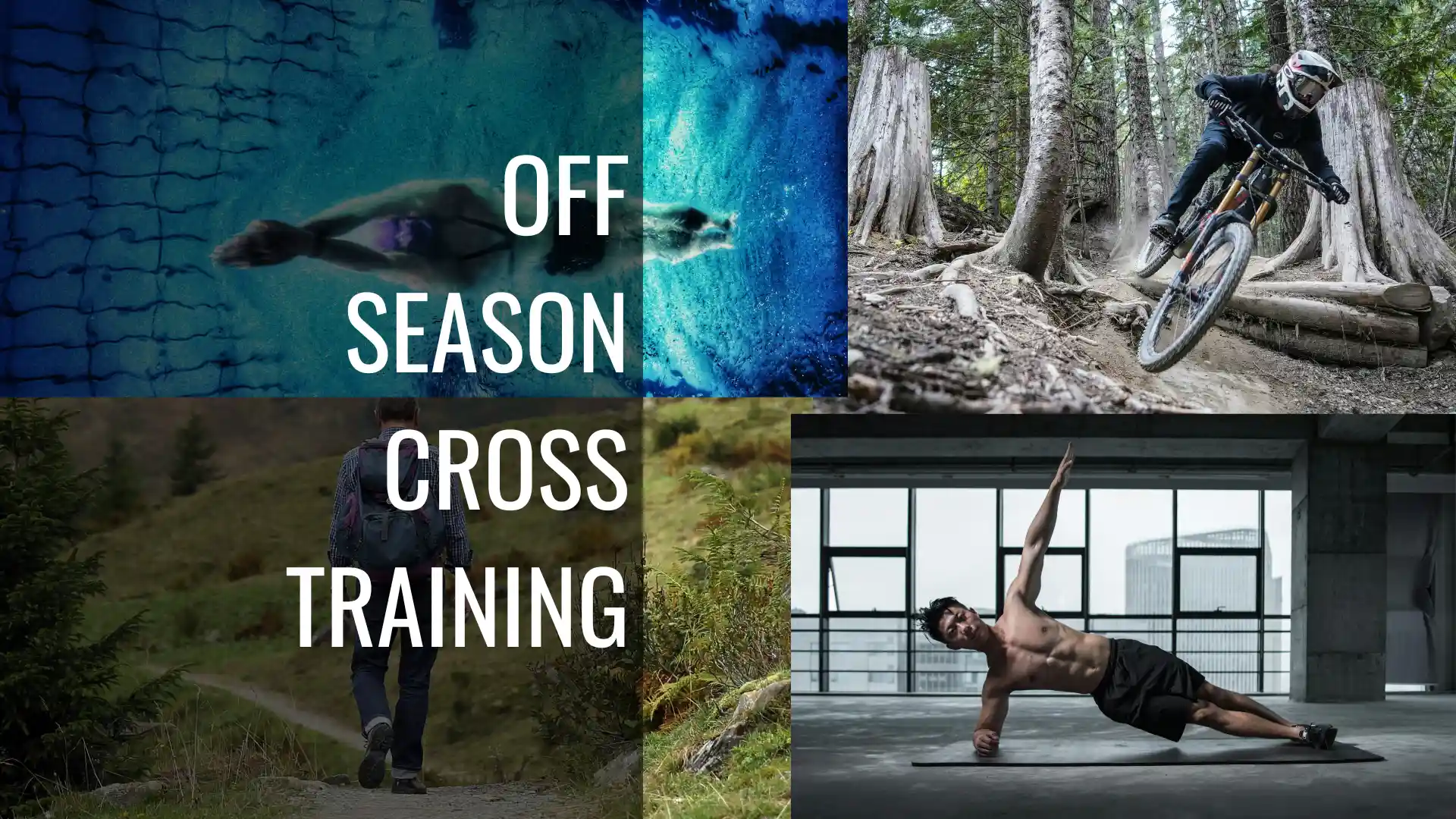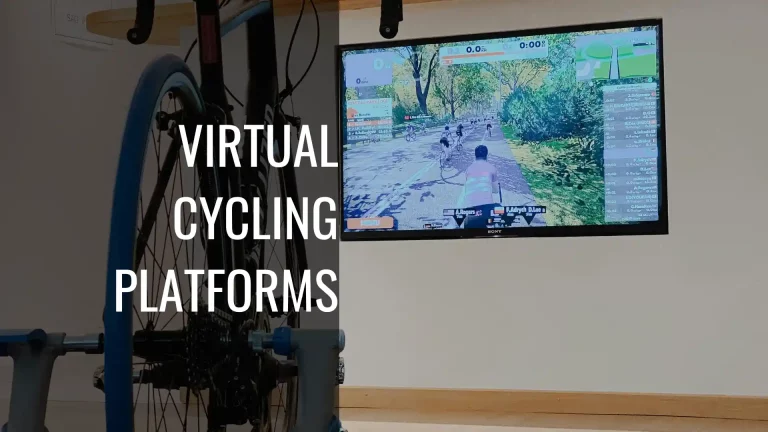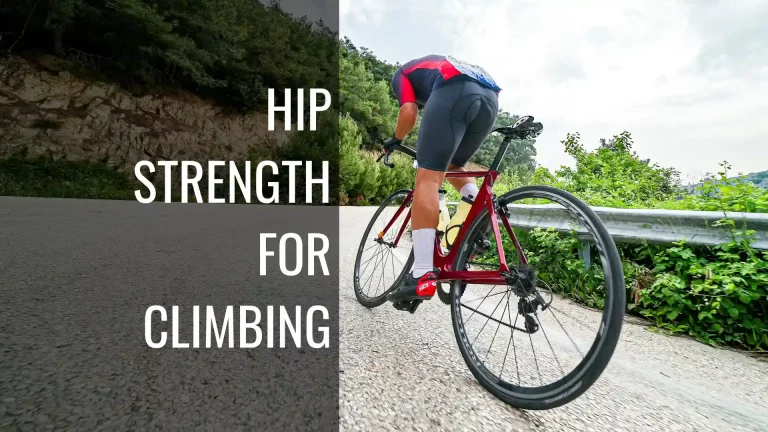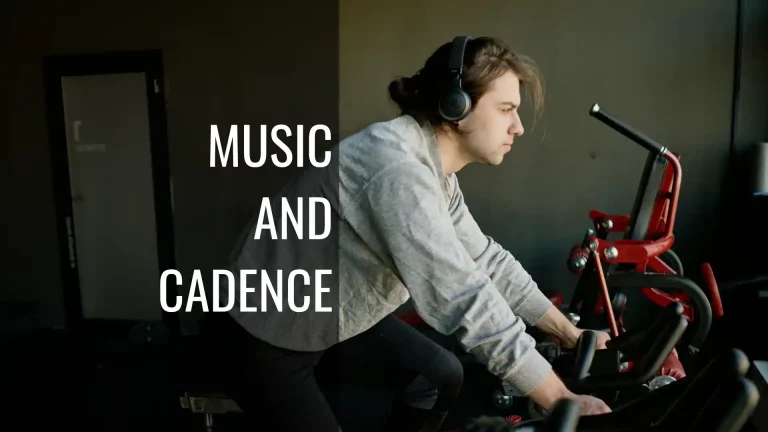
The off-season is more than just a break from cycling. The cycling off-season is a strategic opportunity to become a better, more well-rounded athlete.
While logging endless miles on the bike builds cycling-specific fitness, it can also create muscular imbalances, repetitive strain, and mental burnout.
Cross-training, or engaging in complementary, non-cycling activities, addresses these issues by engaging different muscle groups, movement patterns, and energy systems that cycling alone cannot develop. It allows you to maintain and even boost your aerobic fitness, develop muscle groups often neglected on the bike, and return to the saddle next spring with renewed strength, better bike handling, and a fresh perspective.
Let’s review off-season cycling activities that will help you improve your cycling and retain your fitness levels through the winter months.
PEDAL MY WAY NEWSLETTER
Weekly training tips, cycling strategies, and fitness insights for sustainable performance.
No spam—just actionable guidance to help you train smarter.
Table of Contents
Why Cross-Training Improves Your Cycling Performance
Cross-training might seem counterintuitive—after all, shouldn’t you just ride more to get better at cycling? However, the principle of specificity has its limits. Cycling is a powerful, yet repetitive, activity that primarily engages a specific set of muscles (quads, glutes, and hamstrings) in a fixed range of motion. This narrow-range and non-weight-bearing activity can lead to muscular imbalances, weak stabilizer muscles, and reduced bone density over time. Cross-training activities address these weaknesses by recruiting muscles that cycling neglects, particularly in your core, upper body, and stabilizing muscle groups.
Beyond physical benefits, cross-training prevents overuse injuries by giving cycling-specific muscles and connective tissues time to recover while maintaining overall fitness that translate directly to faster, more efficient, and injury-free riding, such as:
Addresses Muscle Imbalances: Cycling can lead to a powerful front-chain (quads/hip flexors) and a relatively weaker posterior chain (glutes/hamstrings) and upper body. Cross-training activities like swimming, hiking, and Pilates engage these neglected muscles, creating a more balanced and efficient overall athlete.
Boosts Aerobic Capacity (VO2 Max): Weight-bearing activities like running or Nordic skiing often push your cardiovascular system differently than cycling, challenging your lungs and heart to work harder. This can lead to an improved VO2 max, the maximum amount of oxygen your body can use, which is a key metric for endurance performance.
Increases Bone Density: Cycling is non-weight-bearing, which can be a drawback for bone health over the long term. Activities that involve impact, such as running or hiking, apply load to the bones, stimulating them to become stronger and reducing the risk of osteoporosis and stress fractures.
Prevents Mental Burnout: A break from the saddle and the structured nature of cycling training can be a powerful psychological refresh. Engaging in enjoyable, varied activities helps keep your passion for the sport alive.
Running for Cyclists: Building Cardiovascular Fitness Differently
Running offers cyclists a time-efficient way to maintain cardiovascular fitness while developing leg strength through a completely different movement pattern.
Unlike the circular pedaling motion, running requires eccentric muscle contractions as you absorb impact with each foot strike, building strength and resilience in your muscles, tendons, and bones. This impact loading is particularly valuable for cyclists, as it stimulates bone remodeling and helps prevent the low bone density that can result from cycling’s non-weight-bearing nature.
Running typically pushes your heart rate higher than cycling at the same perceived effort, offering a powerful stimulus to your aerobic system.
Cyclists new to running must approach it cautiously. Your cardiovascular system may be ready to tackle significant distances, but your musculoskeletal system needs time to adapt to impact forces.
- Start with easy runs of 20-30 minutes on softer surfaces like trails, grass, or tracks, focusing on comfortable paces where you can maintain a conversation.
- Run no more than 2-3 times per week initially (e.g., 15-20 minutes, 2-3 times per week), with rest days in between. Focus on time, not distance. Hill repeats or short tempo runs are highly effective, mimicking the high-power, high-cardio demands of cycling intervals while building crucial bone density.
- Pay attention to your running form—maintain an upright posture, land with your feet beneath your hips, and avoid over-striding.
As your body adapts over several weeks, you can gradually increase duration and frequency. The goal isn’t to become a competitive runner but to complement your cycling with an activity that challenges your body in new ways while maintaining your aerobic base.
Swimming Offers Low-Impact Cardio That Complements Cycling
Swimming stands out as the perfect complement to cycling.
This zero-impact activity delivers an excellent recovery activity and cardiovascular workout while engaging your entire body, particularly the upper body, core, and back muscles that cycling largely ignores. The horizontal position in water provides a welcome break from the hunched cycling posture, helping to counteract the rounded shoulders, tight hip flexors, and compressed spine that many cyclists develop over time.
The Benefits of Swimming for Cardio
- Low-Impact Recovery: As a zero-impact activity, swimming allows your cycling-specific muscles and joints to recover while maintaining a high level of aerobic fitness. It’s an ideal choice for recovery days.
- Upper Body and Core Strength: Unlike cycling, swimming is a full-body workout that engages the upper body (back, shoulders, arms) and core far more intensely. This balanced development improves your core stability and ability to maintain a strong, comfortable position on the bike for hours.
Breathing Control: Swimming requires rhythmic, controlled breathing, which helps improve lung capacity and teaches you to manage your breath under high exertion—a skill directly applicable to climbing or intense efforts on the bike.
Plan and Prepare:
- In the pool, focus on strokes that promote balance and posture.
- Freestyle builds shoulder strength and rotational core stability, while backstroke opens up your chest and strengthens the posterior chain muscles that support proper bike positioning.
- Breaststroke can improve hip flexibility and strengthen your inner thighs.
- Aim for 2-3 swim sessions per week, starting with 20-30 minutes and building up to 45-60 minutes as your technique and endurance improve.
- If you’re new to swimming, consider taking a few lessons to learn efficient technique—proper form makes swimming far more enjoyable and effective.
The resistance of water provides strength benefits without the joint stress of weights. The rhythmic breathing enhances lung capacity and teaches breath control that translates directly to managing efforts on the bike.
Yoga Helps Cyclists Build Flexibility and Mobility
Cyclists’ muscles are notoriously tight. Spending hours in a flexed position shortens hip flexors, hamstrings, and lower back muscles while weakening glutes and core stabilizers.
While the priority is power, flexibility and mobility are the unsung heroes of on-bike efficiency and comfort.
Yoga addresses these imbalances through a combination of flexibility work, mobility training, and functional strength building. Unlike passive stretching, yoga’s active poses engage muscles while lengthening them, creating both flexibility and stability around your joints.
Focus on styles and poses that target cycling-specific problem areas.
- Hip-opening poses like pigeon, low lunge, and butterfly stretch the chronically tight hip flexors and external rotators.
- Forward folds and downward dog lengthen hamstrings and calves, while poses like cobra and camel counteract the forward-flexed cycling position by opening the chest and strengthening the back.
- Core-focused poses like plank, boat, and side plank build the abdominal and oblique strength necessary for efficient power transfer and bike handling. Aim for 2-3 yoga sessions per week, ranging from 30-60 minutes.
Key Benefits of Yoga for Cyclists:
- Targets Cyclist Tightness: Cycling leads to tight hip flexors, hamstrings, and a rounded upper back. Yoga poses can specifically target these areas, restoring range of motion and improving the efficiency of your pedal stroke.
- Improved Posture and Power Transfer: By increasing flexibility in the hips and spine, yoga allows you to maintain a more aerodynamic and comfortable position on the bike. This improved posture ensures that the power generated by your legs is efficiently transferred to the pedals, rather than being wasted due to a restricted body position.
- Mind-Body Connection: Yoga improves body awareness and breathing control, helping you recognize muscle tension and relax into a better form both on and off the bike.
Many cyclists find that even 15 minutes of daily yoga makes a noticeable difference in how they feel both on and off the bike.
Hiking and Trail Running Builds Leg Strength on Varied Terrain
Getting off the pavement and onto uneven ground is an excellent way to build functional strength and engage stabilizing muscles.
Hiking and trail running force your legs to work in ways that smooth pavement and circular pedaling never do. The constantly changing terrain, including navigating rocks, roots, elevation changes, and uneven surfaces, requires dynamic balance, proprioception, and engagement of stabilizer muscles throughout your legs, ankles, and core.
Each uphill push strengthens your glutes, quads, and calves through a fuller range of motion than cycling, while downhill sections build eccentric strength and knee stability.
The variable intensity of hiking and trail running also provides natural interval training. In addition:
- Conditioning: Steep climbs spike your heart rate and build muscular endurance, while flatter or downhill sections offer recovery. This varied effort mimics the demands of real-world cycling, where terrain constantly changes. Unlike road running’s repetitive impact, trail surfaces offer more cushioning and force constant adjustments that strengthen small stabilizing muscles around your ankles and knees.
- Stabilizing Muscle Activation: Unlike the smooth, repetitive motion of pedaling, hiking, and trail running on varied terrain (rocks, roots, inclines) forces the smaller stabilizing muscles around your ankles, knees, and hips to fire constantly. This leads to joint stability and helps prevent injury.
Uphill Strength: Steep hiking or power-hiking up hills is a fantastic low-impact way to build explosive leg strength in your glutes and hamstrings, mimicking the muscular demands of a steep climb.
Mental Engagement: The natural surroundings and need to focus on foot placement provide a great mental break from the road, enhancing enjoyment and reducing the feeling of “training.” Time in nature reduces stress and rekindles the sense of adventure that drew many of us to cycling in the first place. Plus, scouting trails during the off-season gives you new routes to explore on your mountain bike come spring.
Start with moderate hikes of 1-2 hours on rolling terrain, gradually progressing to longer outings or steeper mountains. If you’re trail running, begin on well-maintained trails before tackling more technical terrain.
Nordic Skiing is The Perfect Full-Body Winter Workout for Cyclists
Cross-country skiing might be the ultimate winter cross-training activity for cyclists, especially if you live in a snowy climate, as Nordic (cross-country) skiing is arguably the gold standard of off-season cross-training.
Whether you’re classic skiing or skate skiing, this full-body cardiovascular workout closely mimics cycling’s aerobic demands while engaging your upper body, core, and legs through powerful, coordinated movements. In fact, many professional cyclists incorporate Nordic skiing into their winter training because it maintains aerobic capacity without the repetitive stress of cycling.
Skate skiing, in particular, offers remarkable benefits.
- Maximum Aerobic Demand: Nordic skiing consistently tests as one of the most demanding endurance sports, engaging almost every muscle group simultaneously. It is exceptional for building a high VO2 max and overall aerobic fitness.
- Full-Body Power: The side-to-side skating motion requires coordinating power from your legs (kicking or skating motion), core, and upper body (poling). This strengthens your glutes, hip abductors, and core stabilizers—muscles that are crucial for powerful, stable cycling but often underdeveloped. The double-pole technique supports upper body power and core strength that translates directly to better climbing, sprinting, and bike handling. Classic skiing provides similar benefits with a slightly more accessible learning curve and lower impact on your legs. Both styles teach rhythmic, efficient movement and controlled breathing under sustained effort—skills that directly enhance your cycling.
- Low Impact: Despite the high effort, the gliding motion of skiing is relatively low-impact, making it gentler on the joints than running. Actually you can train at various intensities, from easy aerobic outings to high-intensity interval sessions, all while enjoying winter landscapes and fresh air.
If you have access to groomed trails or backcountry skiing terrain, aim for 1-2 sessions per week depending on your fitness and goals. The coordination and balance required also sharpen your kinesthetic awareness, making you a more skillful bike handler when you return to cycling.
Pilates and Core Strengthening for Better Bike Handling
A strong core is the foundation of efficient cycling, acting as the stable platform from which your legs generate power. It stabilizes your pelvis, supports power transfer from your legs to the pedals, and maintains proper positioning during long rides or hard efforts. Yet cycling itself does relatively little to build core strength.
Pilates addresses this gap through controlled, precise movements that target deep stabilizing muscles in your abdomen, back, hips, and pelvic floor.
Pilates is an excellent way to build deep, functional core strength.
- The Powerhouse: Pilates focuses on strengthening the “powerhouse”—the core muscles that connect your upper and lower body – the deep abdominal and back muscles—which are crucial for holding a stable pelvic position on the bike.
- Improved Posture and Endurance: A strong core prevents excessive movement in the upper body, ensuring that energy is directed only into the pedals.
- The emphasis on controlled movement, proper breathing, and body awareness translates directly to better positioning and efficiency on the bike.
- Stability not only increases power transfer but also delays fatigue in your back and shoulders on long rides. Exercises like the hundred, roll-ups, and leg circles build abdominal strength and hip stability, while movements like swimming and back extensions strengthen the posterior chain that supports your spine during long rides.
- Stronger core muscles mean less energy wasted through unwanted movement, better power transfer to your pedals, and reduced fatigue in your lower back during extended efforts.
- Injury Prevention: By improving spinal and pelvic stability, Pilates helps prevent common cycling ailments like lower back pain and saddle sores caused by shifting in the saddle due to a fatigued core.
You don’t need expensive equipment to benefit from Pilates—mat-based routines are highly effective and can be done at home. Aim for 2-3 sessions per week, focusing on 30-45 minute workouts that emphasize quality over quantity.
Many cyclists find that consistent Pilates practice eliminates chronic lower back pain and improves their ability to maintain aerodynamic positions. If you’re new to Pilates, consider a few private sessions or classes to learn proper form and breathing techniques before practicing independently.
Mountain Biking: Keeping Your Cycling Skills Sharp
If you’re primarily a road cyclist, the off-season is the perfect time to explore mountain biking. Keeping you on two wheels, mountain biking challenges different skills than the road bike, including technical handling, quick decision-making, explosive power, and dynamic balance. Navigating trails requires constant micro-adjustments, engaging stabilizer muscles and neural pathways that steady-state road riding doesn’t develop.
Mountain biking is a brilliant way to cross-train that keeps you on the bike while challenging different skill sets, which translates directly to road cycling:
- Bike Handling Mastery: Single-track and technical trails force you to react quickly, choose lines, corner sharply, and maneuver the bike—skills that dramatically improve your confidence and safety in a fast-paced road peloton or a tricky descent. When you’ve successfully navigated rocky descents and tight switchbacks, handling your road bike in a fast criterium or on wet pavement feels far less intimidating.
- Short Power Bursts: The stop-start nature of mountain biking often requires repeated, explosive power bursts to clear obstacles or navigate short, steep rises, developing the anaerobic capacity and fast-twitch muscle fibers that are vital for attacks and sprints. The explosive efforts required for technical climbs and obstacles develop anaerobic power and leg strength in ways that sustained road rides cannot. The variety of terrain and intensity provides natural interval training without the mental grind of structured workouts.
- Bone Density: Similar to running, the micro-impacts of riding off-road contribute to better bone mineral density than riding exclusively on smooth asphalt.
Beyond the physical benefits, mountain biking reignites the pure joy of riding. There’s no worrying about power numbers, average speeds, or Strava segments. It’s just you, your bike, and the trail ahead. This mental break is crucial for long-term motivation and preventing burnout.
Aim for 1-2 mountain bike rides per week during the off-season, focusing on technical skill development rather than all-out fitness efforts. Start with easier trails to build confidence and gradually progress to more challenging terrain. The bike-handling skills, power, and mental freshness you develop will make you a more capable, confident cyclist when you return to your primary discipline.
How Much Cross-Training Is Too Much?
The off-season is about maintaining fitness and building a foundation, not accumulating fatigue or risking injury through overzealous cross-training. The key is finding the sweet spot where you’re active enough to maintain cardiovascular fitness and address weaknesses without overtraining or interfering with your cycling-specific development.
A general guideline is to structure your week around 5-7 hours of total aerobic activity during the off-season, mixing cycling with 2-4 sessions of complementary activities. This might look like 2-3 shorter cycling sessions (indoor or outdoor), 2 cross-training workouts (swimming, running, or Nordic skiing), and 2 yoga or Pilates sessions. The exact balance depends on your goals, experience with different activities, and how your body responds.
If you’re new to running or high-impact activities, start conservatively with just 1-2 sessions per week while your musculoskeletal system adapts.
A few tips before you start your new training routine:
Listen to Your Body: The simplest rule is if your cross-training activity is leaving you too fatigued to do your intended cycling (or general life activities), you’re doing too much. Watch for declining performance, increased resting heart rate, mood changes, or nagging aches that don’t resolve with rest.
Prioritize Low-Impact: For cyclists focused on high volume and speed, high-impact activities like running should be limited to 1-3 short sessions per week to minimize injury risk. Remember that different activities stress your body in different ways—while swimming is low-impact, it still taxes your cardiovascular system and muscles. Similarly, yoga might seem gentle, but an intense power yoga session can be quite demanding.
Focus on Consistency, Not Volume: During the off-season, consistency with your cross-training is more important than massive volume. Two to four sessions per week of varied cross-training (e.g., one run, one yoga/Pilates session, and one strength session) is often more than enough to reap significant benefits.
The off-season should leave you feeling refreshed and excited to return to structured training, not depleted and burned out. When in doubt, err on the side of doing slightly less rather than more.
Balancing Cross-Training with Cycling-Specific Workouts
The challenge during the off-season is maintaining enough cycling-specific fitness so you don’t start from zero when structured training begins, while still benefiting from the variety and recovery that cross-training provides.
The off-season is the time to shift the ratio of your training, dedicating more time to complementary work while reducing cycling volume and intensity.
The Transition Phase (Early Off-Season): Focus heavily on rest, mental recharge, and maintenance of light, fun, low-intensity cycling. This is the ideal time to introduce a higher volume of new cross-training activities (strength, yoga, new sports) to build that foundation.
The Base Phase (Mid-Off-Season): This is where you find the balance. Dedicate 2-3 days per week to cross-training (focused on strength, core, and flexibility) and 3-4 days to structured, low-to-moderate-intensity, longer cycling rides to build your aerobic base. Schedule the cross-training on non-cycling days or keep it entirely separate from hard cycling efforts (e.g., morning cross-train, afternoon easy spin, or separate by 6+ hours).
Avoid Competing Stimuli: Do not do a heavy leg strength session immediately before or after a high-intensity cycling workout, as this can blunt the positive adaptations of both. Allow for a recovery day or an easy spin after a hard strength session.
This progressive transition allows you to carry the strength, flexibility, and mental freshness from cross-training into your structured cycling program without losing the bike-specific fitness and neuromuscular patterns that make you an efficient cyclist.
Track how you feel and perform rather than rigidly following a percentage. Your body will tell you when it’s ready to focus more specifically on cycling.
Setting the Stage for Seasonal Cycling Success
The off-season is a valuable training phase for cyclists. By thoughtfully incorporating cross-training activities into your routine, you’ll address the physical imbalances and weaknesses that cycling alone cannot fix, reduce your risk of overuse injuries, and maintain the mental freshness that fuels long-term passion for the sport.
Whether you’re swimming laps to build upper body strength, exploring snowy trails on Nordic skis, or flowing through yoga poses to regain mobility, each activity contributes to making you a more complete athlete.
When spring arrives and you’re ready to ramp up your cycling-specific training, you will enter the season with a more resilient body, sharpened bike handling skills, and a refreshed mental state. This holistic approach ensures you don’t just maintain fitness, but you emerge from the off-season next spring stronger, more efficient, and ready to tackle your biggest goals with renewed energy and fewer limitations.
The miles you don’t ride during the off-season might be the most valuable training you do all year.






